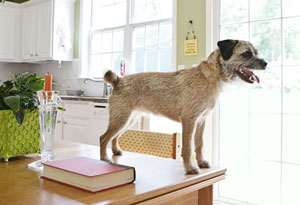
Photo: Christopher T. Martin
It's easy to see why Megan Wargula spoiled her two border terriers: They're adorable! O steps in to help transform these neighborhood nuisances into model pets.
Reader Name: Megan WargulaAge: 35
Profession: Marketing manager and stationery entrepreneur
Family: Husband Michael Harbin, 39
Hometown: Woodstock, Georgia
"You know when you see spoiled-rotten kids, and you think, 'Who raised them to act this way?'" says Megan Wargula when dog trainer Victoria Stilwell arrives at Wargula's home. "That's our dogs." Her two border terriers, Finlay, 6, and Riley, 3 (above), seem eager to prove her point. Finlay yaps and paws the kitchen cabinet in search of food, while Riley, distracted by a squirrel in the backyard, unleashes a deafening howl. Wargula scolds them halfheartedly and apologizes.
It wasn't always this way. She and her husband, Michael Harbin, got Finlay as a puppy. If they overlooked any misbehavior, it was only because he was so darn cute! But when they added Riley to the family, the 15-pound dogs egged each other on, becoming rowdy and noisy, and snapping at other pets in the neighborhood. Then last Thanksgiving at Wargula's parents' house, Riley jumped up onto Wargula's lap during dinner, splashing scalding gravy onto her arm. The incident sparked a family argument, and her normally canine-loving parents asked Wargula to leave the dogs at home in the future.
"We've got a mess on our hands," Wargula admits. Stilwell, star of Animal Planet's It's Me or the Dog, agrees—but explains that her strategy focuses on bringing the humans into line, not the canines. "Owners often get angry with their dogs for conduct they've encouraged," she says. After listening to Wargula's complaints and observing the dogs for only a few minutes, Stilwell can see three main problem areas:
Bad Behavior #1: Relentless whining and barking. Says Wargula: "If they see a squirrel or a lizard in the backyard, it's mayhem!"
Wargula's mistake: Regularly letting the dogs out when they see a critter they want to chase rather than ignoring the bad behavior. "Unfortunately, this has taught them, When I bark, I get to go out," says Stilwell.
The solution: "From now on, the only thing that will get them what they want is quiet," Stilwell instructs. "If you have to endure 30 minutes of barking, use earplugs! Wait for that silence, and it will come." Stilwell cautions that a burst of frenzied barking might precede this promised silence, as the dogs express their frustration. "That's how you'll know it's working," she says.
Bad Behavior #2: Terrorizing other dogs, particularly the neighbors' golden retriever.
Wargula's mistake: Taking the dogs on fewer walks to avoid the problem rather than dealing with it directly.
The solution: "They're terriers!" says Stilwell. "They need an outlet for their energy." Because their behavior is worse when they're together, she prescribes an hour a day of individual walks until the dogs learn to be civil; only then can Wargula walk them jointly. Next, Stilwell addresses the aggression. She takes Riley for a walk and instructs Wargula to borrow the neighbors' golden retriever and walk her down the opposite side of the street. Sure enough, Riley yelps and pulls at the leash when she sees the larger dog. Immediately, Stilwell turns Riley around and leads her back toward Wargula's house. When the dog stops barking, she pivots and resumes the walk. After several repetitions, Riley figures out that barking will get her nowhere, and she passes the retriever without incident.
One more bad behavior solved, plus Stilwell's 4 tips for raising a well-behaved dog

Wargula looks on as Stilwell teaches Finlay to "leave it."
Bad Behavior #3: Jumping up to forage for food. "One day Finlay snatched sugar-free gum from the dining table," says Wargula. "It's toxic for dogs, so we spent $40 an hour on an overnight stay at the emergency vet!"
Wargula's mistake: Inconsistency. "I try to keep Finlay off the table by scolding him when he jumps up, but it's hard to be strict all the time," she says.
The solution: Stilwell teaches Finlay the directive "leave it." To do this, she gets down on the kitchen floor—again, training one dog at a time—and places a treat in her fist, which Finlay immediately tries to dislodge with his mouth. "I'm waiting for him to lose interest," says Stilwell. After five minutes, he finally moves his snout, and Stilwell rewards him with a treat from a red pouch. After several repetitions, Finlay learns that ignoring the treat in Stilwell's fist will get him a treat from her pouch. Next, she begins saying "leave it" when she places the treat in her fist, attaching a command to the desired outcome. Finlay obeys. Eventually Stilwell ups the ante and places a treat on the floor. "Leave it," she says. Still, he doesn't touch it. Stilwell tries one final challenge: tossing the treat a few feet away. Finlay eyes the morsel—but again, he doesn't make a move.
When O checked in with Wargula a month later, she was still feeling the afterglow of Stilwell's visit. "Riley is so well behaved on walks," she says. "Recently, a much larger dog came barreling down the street after escaping his leash, but Riley just ignored him." Finlay, meanwhile, sits quietly at the back door when he wants to go out, and they both have made good progress on the "leave it" command. "I had tried to educate myself on how to train them, but nothing was working for us," Wargula says. "That day with Victoria, it's like a lightbulb went on."
2. Don't dominate—cooperate. It's better to prevent misconduct (using positive reinforcement) than to punish it, says Stilwell. Teach your dog that good things come from good conduct, and he'll choose to behave.
3. Find out what motivates your dog to learn. It's a myth that dogs respond only to food—they could also want toys, praise, or attention. Vary the rewards to keep him engaged.
4. But don't neglect discipline. If your dog misbehaves, ignore him (for example, turn your back when he's jumping on you), give him a short time-out in another room, or redirect his energy toward something more positive, like a toy.
More on Our Furry Four-Footed Friends:
Wargula's mistake: Inconsistency. "I try to keep Finlay off the table by scolding him when he jumps up, but it's hard to be strict all the time," she says.
The solution: Stilwell teaches Finlay the directive "leave it." To do this, she gets down on the kitchen floor—again, training one dog at a time—and places a treat in her fist, which Finlay immediately tries to dislodge with his mouth. "I'm waiting for him to lose interest," says Stilwell. After five minutes, he finally moves his snout, and Stilwell rewards him with a treat from a red pouch. After several repetitions, Finlay learns that ignoring the treat in Stilwell's fist will get him a treat from her pouch. Next, she begins saying "leave it" when she places the treat in her fist, attaching a command to the desired outcome. Finlay obeys. Eventually Stilwell ups the ante and places a treat on the floor. "Leave it," she says. Still, he doesn't touch it. Stilwell tries one final challenge: tossing the treat a few feet away. Finlay eyes the morsel—but again, he doesn't make a move.
When O checked in with Wargula a month later, she was still feeling the afterglow of Stilwell's visit. "Riley is so well behaved on walks," she says. "Recently, a much larger dog came barreling down the street after escaping his leash, but Riley just ignored him." Finlay, meanwhile, sits quietly at the back door when he wants to go out, and they both have made good progress on the "leave it" command. "I had tried to educate myself on how to train them, but nothing was working for us," Wargula says. "That day with Victoria, it's like a lightbulb went on."
Victoria Stilwell's 4 Tips for Raising a Well-Behaved Dog
1. Consider life from his point of view. "We can't expect dogs to know that it's not socially acceptable to grab food off the dinner table," says Stilwell. "Yet we still punish for bad behavior without first teaching them what's right and what's wrong."2. Don't dominate—cooperate. It's better to prevent misconduct (using positive reinforcement) than to punish it, says Stilwell. Teach your dog that good things come from good conduct, and he'll choose to behave.
3. Find out what motivates your dog to learn. It's a myth that dogs respond only to food—they could also want toys, praise, or attention. Vary the rewards to keep him engaged.
4. But don't neglect discipline. If your dog misbehaves, ignore him (for example, turn your back when he's jumping on you), give him a short time-out in another room, or redirect his energy toward something more positive, like a toy.
More on Our Furry Four-Footed Friends:




